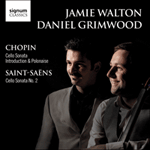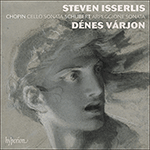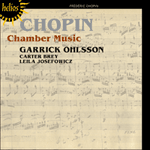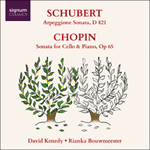
Welcome to Hyperion Records, a British classical label devoted to presenting high-quality recordings of music of all styles and from all periods from the twelfth century to the twenty-first.
Hyperion offers both CDs, and downloads in a number of formats. The site is also available in several languages.
Please use the dropdown buttons to set your preferred options, or use the checkbox to accept the defaults.

For some of Chopin’s contemporaries it was a difficult work to grasp. Moscheles found ‘passages which sound to me like someone preluding on the piano, the player knocking at the door of every key and clef, to find if any melodious sounds were at home’, yet he thought well enough of it to make an arrangement for piano four hands. The Allegro moderato, especially, puzzled even Chopin’s intimates—players today find it the most problematic in terms of balance—and he omitted the movement at the premiere given by himself and Franchomme, the work’s dedicatee, on 16 February 1848. This first movement clearly had some hidden significance for him. Various commentators have noted in it thematic references from Schubert’s Winterreise, notably the initial phrase of ‘Gute Nacht’, the opening song. The subject of the song-cycle, the disappointed lover in despair at leaving his beloved, would seem to reflect the circumstances of Chopin’s life when he was writing the Sonata. There is evidence that he turned to Winterreise at the time of his separation from George Sand. Could that be why the first movement was not played at the premiere? Is that why on his deathbed he asked Franchomme to play it but could not bear to hear more than the opening bars?
from notes by Jeremy Nicholas © 2010
Certains contemporains de Chopin jugèrent cette œuvre difficile à saisir. Moscheles y trouva des passages qui lui firent «penser à quelqu’un préludant au piano, l’interprète cognant à la porte de chaque tonalité, de chaque clef, pour voir si des sonorités mélodieuses s’y sentaient bien»; mais il l’estimait, au point d’en faire un arrangement pour piano à quatre mains. L’Allegro moderato, surtout, dérouta même les intimes de Chopin—les interprètes actuels le considèrent toujours comme le plus problématique, sur le plan de l’équilibre—, lequel ne le joua pas lorsqu’il créa l’œuvre avec Franchomme, son dédicataire, le 16 février 1848. À l’évidence, ce premier mouvement avait pour lui quelque sens caché. Divers commentateurs y ont relevé des références thématiques à la Winterreise schubertienne, notamment à la phrase liminaire du premier lied, «Gute Nacht». Le sujet de ce cycle de lieder, l’amant malheureux désespéré de quitter sa bien-aimée, reflète, semblerait-il, la vie de Chopin: on a la preuve qu’il se tourna vers la Winterreise quand il se sépara d’avec George Sand. Cela pourrait-il expliquer l’omission du premier mouvement, lors de la création? Fut-ce pour cela, aussi, que, sur son lit de mort, il pria Franchomme de le lui jouer mais ne put supporter d’en entendre que les premières mesures?
extrait des notes rédigées par Jeremy Nicholas © 2010
Français: Hypérion
Für manche von Chopins Zeitgenossen war dieses Werk nur schwer verständlich. Moscheles fand „Passagen, die klingen, als präludiere jemand am Klavier, wobei der Spieler an der Türe zu jeder Tonart und jedem Notenschlüssel klopft, um herauszufinden, ob da irgendwelche Melodien zu Hause sind“. Aber wenigstens hielt er so viel von diesem Stück, dass er davon eine vierhändige Bearbeitung anfertigte. Besonders das Allegro moderato verstörte sogar die engsten Freunde Chopins (heutige Spieler haben höchstens an der Balance etwas auszusetzen), und vielleicht ließ er den Satz deshalb bei der Premiere weg, die am 16. Februar 1848 durch ihn und den Widmungsträger Franchomme stattfand. Dieser erste Satz hatte offenkundig irgendeine verborgene Bedeutung für ihn. Verschiedene Kritiker haben in ihm thematische Bezüge zu Schuberts Winterreise festgestellt, vor allem zum Beginn des ersten Liedes „Gute Nacht“. Der Held des Liederzyklus, der enttäuschte Liebende, der verzweifelt darüber ist, seine Geliebte verlassen zu müssen, scheint die Lebensumstände Chopins widerzuspiegeln, als er die Sonate komponierte. So gibt es Anhaltspunkte, dass er sich zur Zeit der Trennung von George Sand mit der Winterreise beschäftigte. Könnte das der wahre Grund sein, warum der erste Satz bei der Premiere nicht gespielt wurde? Hat er deshalb auf seinem Totenbett Franchomme gebeten, ihn zu spielen, konnte aber nicht mehr als die Einleitungstakte ertragen?
aus dem Begleittext von Jeremy Nicholas © 2010
Deutsch: Ludwig Madlener
 Alkan & Chopin: Cello Sonatas Alkan & Chopin: Cello SonatasThis recording of two great Romantic cello sonatas features the mercurial duo of cellist Alban Gerhardt and pianist Steven Osborne, both musicians of dazzling technical and interpretative abilities. Gerhardt is known for his passionate commitment ...» More |
 Chopin & Saint-Saëns: Cello Sonatas Chopin & Saint-Saëns: Cello SonatasTwo works from very different composers: Chopin’s works for cello were few and far between, but these two straddle his compositional life: the Introduction and Polonaise was written in 1829 when he was just 19, and the cello sonata in (1845-6) is ...» More |
 Chopin: Cello Sonata; Schubert: Arpeggione Sonata Chopin: Cello Sonata; Schubert: Arpeggione SonataTwo Romantic cello sonatas in typically committed performances from one of the world’s favourite cellists.» More |
 Chopin: Chamber Music Chopin: Chamber Music |
 Schubert: Arpeggione Sonata; Chopin: Cello Sonata Schubert: Arpeggione Sonata; Chopin: Cello SonataCello and piano (and husband and wife) duo David Kenedy and Rianka Bouwmeester perform the sonatas by Chopin and Schubert (the latter originally composed for arpeggione, a cello/guitar hybrid instrument whose inventor Schubert perhaps wished to hu ...» More |

